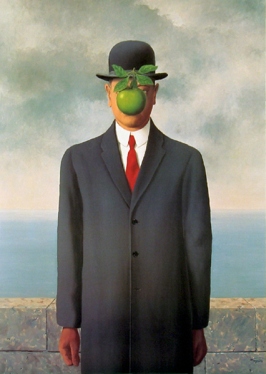Rene Magritte’s 1946 surrealist painting The Son of Man shares a distinct connection with Shakespeare’s Macbeth. In The Son of Man, a man in a jacket and hat stands before a wall, beyond which lies a vast expanse of ocean, as he stares ahead; his view, however, is almost entirely blocked by a green apple floating in front of his face. This painting communicates the message that the apple, maybe a metaphor for emotion or some event, prevents the man from seeing everything else around him. In Macbeth, the witches’ prophesied power is Macbeth’s apple; he is incapable of foreseeing the actions that lead to his fulfillment of the prophecy, just as the man cannot see the ocean behind him, and the prophecy prevents him from clearly understanding the other ramifications of these actions, just as the apple prevents the man from seeing what is in front of him. Additionally, the viewer of the painting cannot see what lies before the man – a direct parallel to the blindness of a reader of Macbeth to what waits for the protagonist with every step he takes toward power. Magritte once said of the painting, “Everything we see hides another thing.” Macbeth is blinded by the idea of ultimate power and respect, his apple consuming his ability to think logically and act rationally. However, the man’s left arm in the painting is bent backwards, a sign that despite the apple blocking his view, he is maybe already imperfect; even without the apple, his ability to act is impaired. Macbeth is clearly an unstable character, consumed by power but also damaged from the beginning of the story. Power is Macbeth’s surrealist apple, preventing him from understanding the present and foreseeing his future, but even if he could look past it, he would still be handicapped by his own inherent faults.

No comments:
Post a Comment